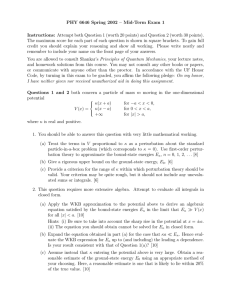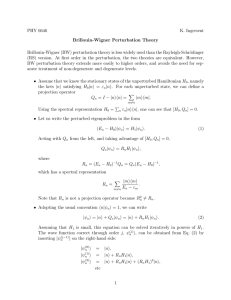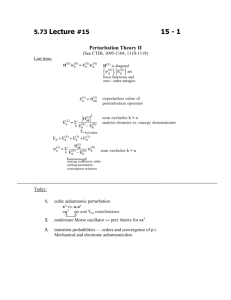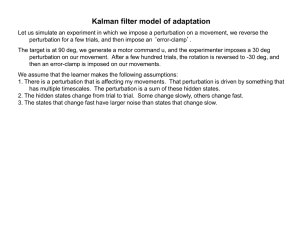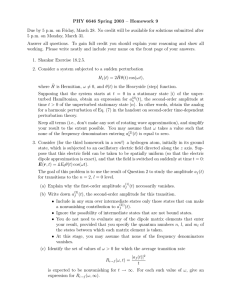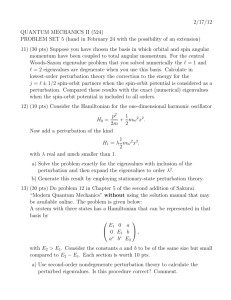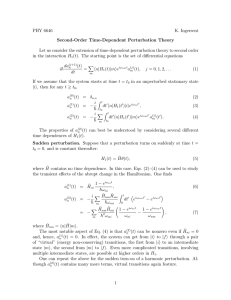Perturbation theory for Maxwell’s equations with shifting material boundaries *
advertisement
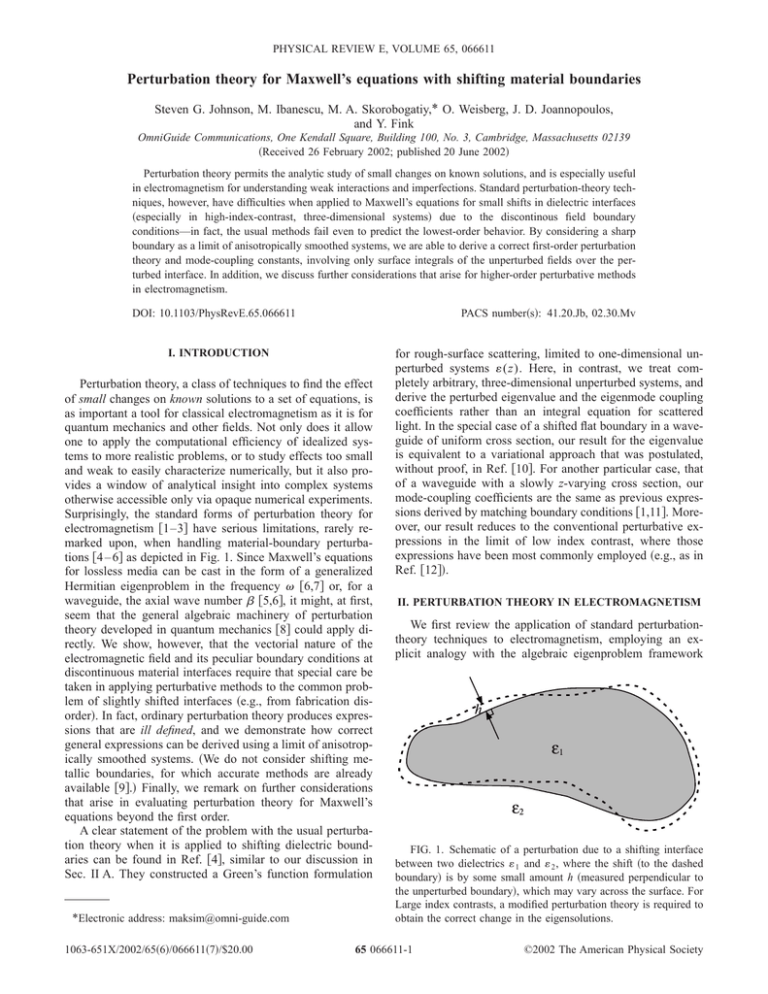
PHYSICAL REVIEW E, VOLUME 65, 066611 Perturbation theory for Maxwell’s equations with shifting material boundaries Steven G. Johnson, M. Ibanescu, M. A. Skorobogatiy,* O. Weisberg, J. D. Joannopoulos, and Y. Fink OmniGuide Communications, One Kendall Square, Building 100, No. 3, Cambridge, Massachusetts 02139 共Received 26 February 2002; published 20 June 2002兲 Perturbation theory permits the analytic study of small changes on known solutions, and is especially useful in electromagnetism for understanding weak interactions and imperfections. Standard perturbation-theory techniques, however, have difficulties when applied to Maxwell’s equations for small shifts in dielectric interfaces 共especially in high-index-contrast, three-dimensional systems兲 due to the discontinous field boundary conditions—in fact, the usual methods fail even to predict the lowest-order behavior. By considering a sharp boundary as a limit of anisotropically smoothed systems, we are able to derive a correct first-order perturbation theory and mode-coupling constants, involving only surface integrals of the unperturbed fields over the perturbed interface. In addition, we discuss further considerations that arise for higher-order perturbative methods in electromagnetism. DOI: 10.1103/PhysRevE.65.066611 PACS number共s兲: 41.20.Jb, 02.30.Mv I. INTRODUCTION Perturbation theory, a class of techniques to find the effect of small changes on known solutions to a set of equations, is as important a tool for classical electromagnetism as it is for quantum mechanics and other fields. Not only does it allow one to apply the computational efficiency of idealized systems to more realistic problems, or to study effects too small and weak to easily characterize numerically, but it also provides a window of analytical insight into complex systems otherwise accessible only via opaque numerical experiments. Surprisingly, the standard forms of perturbation theory for electromagnetism 关1–3兴 have serious limitations, rarely remarked upon, when handling material-boundary perturbations 关4 – 6兴 as depicted in Fig. 1. Since Maxwell’s equations for lossless media can be cast in the form of a generalized Hermitian eigenproblem in the frequency 关6,7兴 or, for a waveguide, the axial wave number  关5,6兴, it might, at first, seem that the general algebraic machinery of perturbation theory developed in quantum mechanics 关8兴 could apply directly. We show, however, that the vectorial nature of the electromagnetic field and its peculiar boundary conditions at discontinuous material interfaces require that special care be taken in applying perturbative methods to the common problem of slightly shifted interfaces 共e.g., from fabrication disorder兲. In fact, ordinary perturbation theory produces expressions that are ill defined, and we demonstrate how correct general expressions can be derived using a limit of anisotropically smoothed systems. 共We do not consider shifting metallic boundaries, for which accurate methods are already available 关9兴.兲 Finally, we remark on further considerations that arise in evaluating perturbation theory for Maxwell’s equations beyond the first order. A clear statement of the problem with the usual perturbation theory when it is applied to shifting dielectric boundaries can be found in Ref. 关4兴, similar to our discussion in Sec. II A. They constructed a Green’s function formulation *Electronic address: maksim@omni-guide.com 1063-651X/2002/65共6兲/066611共7兲/$20.00 for rough-surface scattering, limited to one-dimensional unperturbed systems (z). Here, in contrast, we treat completely arbitrary, three-dimensional unperturbed systems, and derive the perturbed eigenvalue and the eigenmode coupling coefficients rather than an integral equation for scattered light. In the special case of a shifted flat boundary in a waveguide of uniform cross section, our result for the eigenvalue is equivalent to a variational approach that was postulated, without proof, in Ref. 关10兴. For another particular case, that of a waveguide with a slowly z-varying cross section, our mode-coupling coefficients are the same as previous expressions derived by matching boundary conditions 关1,11兴. Moreover, our result reduces to the conventional perturbative expressions in the limit of low index contrast, where those expressions have been most commonly employed 共e.g., as in Ref. 关12兴兲. II. PERTURBATION THEORY IN ELECTROMAGNETISM We first review the application of standard perturbationtheory techniques to electromagnetism, employing an explicit analogy with the algebraic eigenproblem framework FIG. 1. Schematic of a perturbation due to a shifting interface between two dielectrics 1 and 2 , where the shift 共to the dashed boundary兲 is by some small amount h 共measured perpendicular to the unperturbed boundary兲, which may vary across the surface. For Large index contrasts, a modified perturbation theory is required to obtain the correct change in the eigensolutions. 65 066611-1 ©2002 The American Physical Society STEVEN G. JOHNSON et al. PHYSICAL REVIEW E 65 066611 developed for quantum mechanics. There are a number of ways in which Maxwell’s equations can be written as an eigenproblem, but it suffices to focus on one: the generalized eigenproblem in the electric field 兩 E 典 with time dependence e ⫺i t in a source-free linear dielectric (x): “⫻“⫻ 兩 E 典 ⫽ 冉冊 c 2 兩E典, 共1兲 where we use the Dirac notation of basis-independent state kets 兩 E 典 and inner products 具 E 兩 E ⬘ 典 ⬅ 兰 E* •E⬘ dV 关8,13兴. Assuming that is purely real 共lossless兲 and positive, then this eigenproblem is Hermitian and positive semidefinite, leading to real- solutions. Since it is a generalized eigenproblem, the eigenstates are orthogonal under the inner product 具 E 兩 兩 E ⬘ 典 . Typically, one is concerned with bound modes 共e.g., in a cavity or waveguide兲 and/or periodic systems where Bloch’s theorem applies 关7兴, and so the integrals are effectively of finite spatial extent and the eigenvalues are discrete. To apply perturbation theory, one must have some small parameter ⌬ ␣ characterizing the perturbation—for example, ⌬ ␣ could be ⬃⌬ for a small change in , or the volume ⌬ ␣ ⬃⌬V of the change for a small boundary shift of a piecewise constant . Then, in the standard method 关8兴, the new eigensolutions 兩 E 典 and are expanded in powers n of ⬁ ⬁ 兩 E (n) 典 and ⫽ 兺 n⫽0 (n) , with 兩 E (0) 典 and ⌬ ␣ : 兩 E 典 ⫽ 兺 n⫽0 (0) being the unperturbed eigensolution and where the nth term is proportional to (⌬ ␣ ) n . Corrections 兩 E (n⬎0) 典 are defined such that 具 E (0) 兩 兩 E (n⬎0) 典 ⫽0, and the series are substituted into Eq. 共1兲 and solved order by order. †In the case of degenerate 共equal- ) unperturbed modes, the well-known modification of degenerate perturbation theory must be applied: linear combinations are chosen to diagonalize the firstorder correction 关8兴.‡ The first-order correction (1) from a perturbation ⌬ is then easily found to be (1) ⫽⫺ (0) 具 E (0) 兩 ⌬ 兩 E (0) 典 . 2 具 E (0) 兩 兩 E (0) 典 共2兲 This can be thought of as either an approximate expression for the change in due to the perturbation 共accurate as long as 具 E (0) 兩 ⌬ 兩 E (0) 典 is small兲, or an exact expression for the derivative of in the limit of infinitesimal ⌬ ␣ , (0) d ⫽⫺ d␣ 2 冓 冏 冏 冔 E (0) d (0) E d␣ 具 E (0) 兩 兩 E (0) 典 , 共3兲 which is simply the Hellman-Feynman theorem 关8兴. Similarly, higher-order perturbation theory can be recast as exact expressions for higher-order derivatives of the eigenvalue or the eigenfields. Such an electromagnetic perturbation theory, and equivalent formulations 共sometimes derived via the variational principle instead of the explicit eigenproblem兲, has seen widespread use 关1–3,5兴, e.g., to determine the effect of material losses 共small imaginary ⌬) or nonlinearities (⌬ ⬃兩E兩 2 ). Often, for uniform waveguide fields with (z,t) dependence e i(  z⫺ t) , the eigenproblem is cast instead in terms of the wave number  关5,6兴, in which case the shift can be either derived independently by similar methods or be inferred via the group velocity,  (1) ⫽⫺ (1) /(d /d  ). For convenience, we will focus mainly on the differential form of Eq. 共3兲. A. The problem of shifting boundaries Consider the numerator of Eq. 共3兲 in the case of an interface between two dielectrics, 1 and 2 , that shifts a distance h( ␣ ,u, v ) towards 2 , where (u, v ) parametrize the interfacial surface, as depicted in Fig. 1. Since is a step function, its derivative is a Dirac ␦ function that produces a surface integral over the interface: 冓 冏 冏 冔 冕 E (0) d (0) E ⫽ d␣ dA dh 共 ⫺ 2 兲 兩 E(0) 兩 2 . d␣ 1 共4兲 This integral, however, is manifestly undefined, since the normal component E⬜ to the interface is discontinuous at the boundary 共only D⬜ ⫽E⬜ and the parallel components E储 are continuous兲 关9兴. Alternatively, naively employing the finite-perturbation form of Eq. 共2兲 corresponds to simply picking one side of the interface on which to evaluate E⬜ , which has been shown to yield incorrect results 关5,6兴; the error worsens as the dielectric contrast 共and thus the magnitude of the field discontinuity兲 increases, but it has been a popular method for low-contrast systems 关12兴. 共Of course, for TM fields in two dimensions 共2D兲 that are everywhere parallel to the boundaries 关7兴, there is no problem.兲 Why has perturbation theory failed? The source of the error was the assumption that the lowest-order correction 兩 E (1) 典 is of first order in ⌬ ␣ —here, because of the discontinuous boundary conditions, there are points where the correction E⬜(1) is finite even for infinitesimal ⌬ ␣ , foiling the order-by-order solution of perturbation theory. It might seem that one could simply recast the eigenproblem in terms of the magnetic field 关7兴, which is everywhere continuous, but a similar difficulty arises—not only the field correction, but also the eigen-operators applied to this correction must be of first order in ⌬ ␣ , and “⫻H is discontinuous. In fact, comparing with the H eigenproblem is another way to see that there is a problem in perturbation theory for Maxwell’s equations with large ⌬. Applying the same procedure as for Eq. 共2兲 to the H eigenequation, “ ⫻1/“⫻H⫽( /c) 2 H, and then rewriting in terms of E, one obtains a different result: (0) (1) ⫽ 2 冓 冏 冉 冊冏 冔 E (0) 2 ⌬ 1 E (0) 具 E (0) 兩 兩 E (0) 典 , 共5兲 which is only equivalent to Eq. 共2兲 if ⌬ is the small perturbation parameter 关19兴. Both formulations are ill defined for shifting boundaries 关with Eq. 共5兲, the problem is the discon- 066611-2 PERTURBATION THEORY FOR MAXWELL’S EQUATIONS . . . PHYSICAL REVIEW E 65 066611 ¯ 共 x 兲 ⬅ FIG. 2. Schematic of a small, locally flat region of the dielectric interface from 1 to 2 at x⫽h( ␣ ), where x designates the direction perpendicular to the surface. We consider a perturbation consisting of a small shift of the interface in the direction of 2 . tinuity of D储 兴 and their inconsistency has further unfortunate implications for higher-order perturbation theory, as we discuss in Sec. IV. One way of solving this problem in certain cases is to express the perturbation not as a ⌬, but as a transformation of the coordinate system that moves the boundaries—in this way, the field boundary conditions can be preserved, and the perturbation is expressed via a distorted “⫻ operation. Such a perturbation theory was developed and successfully applied to the problem of uniformly scaled or stretched waveguides: unlike the conventional method, it yields correct results even in high-contrast systems 共e.g., for fiber birefringence兲 关5,6兴. As discussed in Sec. IV, the coordinate-transform method may have additional advantages for computing higher-order corrections. Coordinate transformations, however, are cumbersome to apply for arbitrary interface perturbations, and also result in integrals that are not conveniently localized to the perturbed surface. We circumvent both of these shortcomings by instead deriving a perturbation theory from a limit of systems with smoothed boundaries. B. A solution for shifting boundaries If, instead of a discontinuous transition from 1 to 2 , the dielectric function changes smoothly, then all field components are continuous, ⌬ is small for a small boundary shift, and we can apply Eq. 共3兲 without difficulty. The answer for the discontinous system should then be the limit as the transition becomes sharper and sharper—this limit must be unique, so it does not matter how we do the smoothing so long as the limit is well defined. In order to consider smoothing explicitly, we focus on a small area dA where the interface is locally flat 共deferring until later the question of kinks or corners in the boundary兲, and define x as the coordinate perpendicular to the boundary at x⫽h( ␣ ), depicted in Fig. 2. The local dielectric function is then 共 x 兲 ⫽ 1 ⫹ 共 2 ⫺ 1 兲 ⌰ 共 x⫺h 兲 , 共6兲 where ⌰(x) is the unit step function at x⫽0. To start with, let us consider a simple isotropic smoothing, replacing with ¯ given by 冕 g s 共 x⫺x ⬘ 兲 共 x ⬘ 兲 dx ⬘ , 共7兲 where g s (x) is some smoothing function: a localized function 共distribution兲 around x⫽0, of unit integral, that goes to a Dirac delta function ␦ (x) in the limit as s→0. Thus, ¯ /dh⫽( 1 ⫺ 2 )g s (x⫺h), and the contribution to d ¯ /d ␣ 兩 E (0) 典 from dA in this smoothed system is ( 1 具 E (0) 兩 d ⫺ 2 )dh/d ␣ dA 兰兩 E(0) 兩 2 g s (x⫺h)dx. If we now take s→0, however, we merely recover the original problem: we have the integral of a step function (E⬜2 ) times a ␦ function, and the limit is undefined. If we can stumble across any smoothing method that circumvents this problem, yielding a well-defined limit, then the uniqueness theorem for Maxwell’s equations will mean that we are done—there is no need to otherwise prove that a given smoothing is ‘‘correct’’ 共and such well-defined smoothings are certainly not unique, if any exist兲. At this point, we take a hint from effective medium theory, and realize that the most appropriate boundary smoothing in electromagnetism is anisotropic—different field components should ‘‘see’’ different average dielectric constants 关14 –16兴. Specifically, there is an effective tensor s共 x 兲 ⬅ 冉 ˜ 共 x 兲 ¯ 共 x 兲 ¯ 共 x 兲 冊 共8兲 , so that E储 (Eyz ) sees ¯ from Eq. 共7兲, while E⬜ (E x ) sees instead a harmonic mean ˜ , ˜ 共 x 兲 ⫺1 ⬅ 冕 g s 共 x⫺x ⬘ 兲 共 x ⬘ 兲 ⫺1 dx ⬘ . 共9兲 共Precisely such an anisotropic smoothing has been employed to greatly speed convergence, compared to unsmoothed or isotropically smoothed boundaries, in numerical simulations with finite spatial resolution 关15,16兴.兲 From Eq. 共9兲, one finds ⫺1 ˜ /dh⫽⫺ ˜ (x) 2 ( ⫺1 that d 1 ⫺ 2 )g s (x⫺h), and thus the (0) contribution to 具 E 兩 d s /d ␣ 兩 E (0) 典 from dA is dA dh d␣ 冕 ⫺1 ˜ (0) 2 2 dx 关 ⌬ 12兩 E(0) 储 兩 ⫺⌬ 共 12 兲 兩 E⬜ 兩 兴 g s 共 x⫺h 兲 , 共10兲 ⫺1 ⫺1 )⬅ ⫺1 where ⌬ 12⬅ 1 ⫺ 2 and ⌬( 12 1 ⫺ 2 . Note that ˜ E⬜ is continuous, so when we take the s→0 limit and D⬜ ⫽ g s (x⫺h) becomes ␦ (x⫺h), the result is well defined, giving 冓 冏 冏 冔 冕 E (0) d (0) E ⫽ d␣ dA dh ⫺1 (0) 2 2 关 ⌬ 12兩 E(0) 储 兩 ⫺⌬ 共 12 兲 兩 D⬜ 兩 兴 . d␣ 共11兲 This expression, combined with Eq. 共3兲, yields a correct first-order perturbation theory for arbitrary boundary deformations and arbitrary index contrasts. Reassuringly, if we 066611-3 STEVEN G. JOHNSON et al. PHYSICAL REVIEW E 65 066611 FIG. 3. Comparison of perturbation theory 共symbols兲 and numerical differentiation 共lines兲 for d /d ␣ as a function of ␣ , applied to a Gaussian ‘‘bump’’ of height ␣ on top of a 2a⫻a rectangular dielectric waveguide 共illustrated at the two extremes of the ␣ axis兲. The comparison is shown for the lowest-order modes of even 共filled symbols兲 and odd 共hollow symbols兲 parity with respect to the mirror symmetry plane of the waveguide. apply the same limit process to the alternate first-order perturbation theory of Eq. 共5兲, we get the same result. 共We also check it numerically below.兲 There are two points that we glossed over in the derivation above: the effect of kinks in the surface and of changes in the interface orientation, both of which contributions turn out to be of measure zero. A kink or corner can be thought of as the limit of a tighter and tighter bend in the interface—but in this limit, the area of the kink region goes to zero and the field remains finite, so its contribution to Eq. 共10兲 vanishes. Kinks yield discontinuous changes in the interface orientation, whereas any continuous change can be expressed as a rotation d of the surface in addition to the shift dh, and enters the theory as a rotation matrix transforming the dielectric tensor of Eq. 共8兲. This results in a term proportional to ¯ ⫺ ˜ )d /d ␣ , which integrates to zero in the s→0 limit 共it ( is everywhere finite and is zero away from the interface兲. The same method can be used to determine the coupling coefficients between modes, e.g., for time-dependent perturbation theory 共or z dependent, in waveguides兲, also known as coupled-mode theory 关1,11兴, as well as for higher-order perturbation theory. Such coupling coefficients, derived in the usual way 关8兴, stumble over the same problem with discontinuities as in first-order perturbation theory. The correct coupling coefficient between the unperturbed modes 兩 E 典 and 兩 E ⬘ 典 for a shift h( ␣ ,u, v ) in the interface, using the notation from above, involves 关20兴 the surface integral 冓冏 冏 冔 冕 E d E⬘ ⫽ d␣ dA dh 关 ⌬ 12共 E* 储 •E⬘ 储兲 d␣ ⫺1 ⫺⌬ 共 12 兲共 D⬜* •D⬜⬘ 兲兴 , 共12兲 which is again defined purely in terms of the field components that are continuous across the interface. In the case of a waveguide with slowly z-varying cross section, for coupled-mode equations expanded in the instantaneous eigenmodes at each z, one uses ␣ ⫽z in Eq. 共12兲. If one expands in the eigenmodes of a fixed cross section rather than those of the instantaneous cross section, dh/dz is replaced 共to first order兲 by ⌬h in Eq. 共12兲. This equation can also be used for higher-order perturbation theory 共higherorder derivatives in ␣ ), given that the additional considerations discussed in Sec. IV are addressed. 共The perturbative expansion for finite ⌬ ␣ then follows from the Taylor series.兲 The generalization to multiple shifted interfaces, and/or to a ⌬ that varies over an interface, is obvious. In the case of shifting boundaries for magnetic materials 共nonuniform ⫽1), the perturbation theory’s difficulty and its solution are precisely analogous, with , H, and B substituting for , E, and D, respectively. III. A TEST CASE In order to numerically verify that our perturbation theory for shifting boundaries yields the correct result, we consider an arbitrary test case that exhibits a nonuniform shift of a curved boundary, changing boundary orientations, kinks, and large index contrast, and also lacks any special relationship between the field direction and the surface normal. In particular, we start with a uniform rectangular waveguide 共along z) of index n⫽3 and dimensions 2a⫻a 共where a is an arbitrary length scale兲, surrounded by air (n⫽1). Then, to one of the 2a edges 共lying along the x⫽0 plane兲, we add a 2 2 Gaussian ‘‘bump’’ of height h(y)⫽ ␣ e ⫺y /2w , where the bump width is w⫽a/2, as depicted in the insets of Fig. 3. Note that ␣ ⬍0 corresponds to an indentation, and the bump is abruptly terminated at y⫽⫾a, yielding a shifting surface kink. Given this ‘‘bumped’’ waveguide, we consider the 066611-4 PERTURBATION THEORY FOR MAXWELL’S EQUATIONS . . . PHYSICAL REVIEW E 65 066611 FIG. 4. Absolute fractional difference in d /d ␣ between perturbation theory and numerical differentiation as a function of computational resolution 共in pixels/a) for the even mode of Fig. 3. Each dotted line is the difference at a given ␣ for the lowest-order even mode 共i.e., one line per filled circle of Fig. 3兲, and the thick black line is the mean value. The large oscillations stem from both discretization noise and the fact that the sign of the difference is not fixed 共it sometimes passes almost through zero兲, but the overall trend is the expected power-law decline. lowest-order guided modes, with z dependence e i  z , at a wave number  ⫽ /a, and compute d /d ␣ at various values of ␣ . Since the waveguide is symmetric around y⫽0, we examine the lowest-order modes that are even or odd with respect to this mirror plane 共corresponding to modes mostly polarized along the x or y direction, respectively兲. The fully vectorial eigenfields and frequencies of this structure are computed in a 5a⫻5a supercell with periodic boundaries by preconditioned conjugate-gradient minimization of the block Rayleigh quotient in a plane-wave basis, using a freely available software package 关16兴. 共The size of the supercell is actually irrelevant for our purposes; a small supercell would merely produce the modes of coupled periodic waveguides, and would be just as stringent a test of the perturbation theory.兲 Given these fields for a particular ␣ , we compute the line integral of Eq. 共11兲 over the bump surface 共bilinearly interpolating the fields from the discrete computational grid兲 and then employ Eq. 共3兲 for d /d ␣ . For comparison, we evaluate the explicit numerical derivative d /d ␣ by computing the eigenfrequency at various nearby values of ␣ and applying Ridder’s method of polynomial extrapolation 共which maximizes the resulting precision兲 关17兴. The two answers are compared, as a function of ␣ , in Fig. 3 共at a computational resolution of 75 pixels/a), and demonstrate that the perturbation method yields accurate results. Of course, there are errors in both the perturbation theory and the numerical derivative due to the finite computational resolution, so the two results do not match precisely. Such differences, however, should decline in roughly a power-law relationship with the resolution 关21兴, and we display this decline in Fig. 4 for each value of ␣ evaluated above. The absolute fractional difference between the two derivatives oscillates widely around this decline, of course, due to both the discretization noise 共the boundary shape does not change in a continuous fashion兲 and the fact that the difference is not of a fixed sign 共so it sometimes passes almost through zero, yielding sharp accidental dips兲. Averaging over ␣ to smooth these oscillations results in a clearer picture of the decaying error 共shown as a thick black line in Fig. 4兲. It is also instructive to compare our perturbation theory of Eq. 共11兲 with the incorrect Eq. 共4兲 that ignores the boundary discontinuity—in the latter case, we simply evaluate 兩 E兩 2 on the low-index side of the boundary 关corresponding to the naive application of the standard Eq. 共2兲 for positive ⌬ ␣ 兴. Then, at a resolution of 75 pixels/a, we compute the absolute fractional difference in d /d ␣ with the numerical derivative, as a function of ␣ , and plot the results in Fig. 5. For the incorrect perturbation theory, as in Ref. 关6兴, systematic errors are revealed: significant differences 共exceeding 100%兲 that do not decrease with increasing resolution. The errors here are considerably worse for the even mode than for the odd mode because the latter is mostly polarized parallel to the interface 共minimizing the E⬜ discontinuity兲—although the errors for the odd mode increase as the bump becomes larger and thereby less parallel to E. The error in the incorrect theory is proportional to the surface integral 关 ⌬ 12 / 2x ⫺1 ⫹⌬( 12 ) 兴 兰 dA 兩 D⬜ 兩 2 , where x here is the dielectric on the low-index side of the boundary. If we instead evaluate the incorrect theory on the high-index side, only this x is affected, and so the error changes merely by a constant factor 共of 1/9, in this case兲. IV. REMAINING QUESTIONS Perturbation theory, in principle, provides not only a firstorder correction to an eigenvalue, but also a systematic way to find the series of higher-order corrections to both the eigenvalue and eigenfield. Similarly, coupled-mode theory need not be used in the small-perturbation limit—it can be thought of as an exact set of coupled linear differential equa- 066611-5 STEVEN G. JOHNSON et al. PHYSICAL REVIEW E 65 066611 FIG. 5. Absolute fractional difference in d /d ␣ between perturbation theory and numerical differentiation as a function of bump height ␣ , for a resolution of 75 pixels/a. We plot both our corrected perturbation theory 共solid lines, circles兲 and the ill-defined perturbation theory 共dashed lines, triangles兲 of Eq. 共4兲 in which the discontinuous field is simply evaluated on the low-index side of the interface. Results for the lowest-order even mode are shown as filled symbols and for the odd mode as hollow symbols. tions, expressing the mode in terms of the unperturbed eigenmodes with varying coefficients. For both of these techniques, however, the discrepancy between the perturbative expressions of Eqs. 共2兲 and 共5兲 from the E and H eigenproblems is symptomatic of an underlying problem—the two formulations are only equivalent to first order, and they cannot both be correct to higher orders. How could this be? Both coupled-mode theory and the standard perturbation-theory method 关8兴 for first-order eigenfield or higher-order eigenvalue corrections rely on one key assumption that is false for Maxwell’s equations: they assume that the basis of the unperturbed eigenstates is complete. In fact, when the E eigenproblem is solved, one normally imposes the additional constraint of zero free charge, or “•E⫽0 共whence the discontinuous boundary condition on E⬜ ). The perturbed field E⬘ , however, satisfies “•( ⫹⌬)E⬘ ⫽0, so in general, “•E⬘ ⫽0 and E⬘ cannot be expanded in the basis of the unperturbed fields. Relaxing this divergence-free constraint would mean the inclusion of infinitely many static-field solutions at ⫽0, as seen by taking the divergence of both sides of Eq. 共1兲, which would be 共at the least兲 computationally inconvenient. In contrast, the H eigenproblem involves the constraint “• H⫽0, which is not altered by ⌬, so it appears that the H formulation is correct to higher orders. Alternatively, one could formulate the eigenproblem D or B 共handling ⌬ as well as ⌬兲. For the  eigenproblem 共in waveguides兲, these completeness issues do not seem to arise—there, one works at a fixed ⫽0 frequency, so nondivergenceless fields are always excluded. Even when a complete basis is employed, however, one is likely to encounter convergence difficulties due to Gibb’s phenomena 关18兴 that will arise from the shifted field discontinuities. Thus, it may be desirable to find some corrections to the unperturbed modes in order to make a complete, fast-converging basis for the perturbed system, preferably without solving any new differential equations; perhaps such corrections can themselves be a perturbative expansion. Fortunately, in most cases where perturbation theory is of interest, first-order accuracy is sufficient, and there a poor basis is not a problem. There are situations in which this is not enough, however; for example, when the first-order correction is zero by some symmetry, or if one wishes to explore intentional mode conversion in a strong-coupling limit. If the perturbation is due to shifting boundaries, one possible solution is the coordinate-transformation method alluded to earlier 关5,6兴—since it can preserve the boundary conditions, there are indications that it is able to efficiently compute, e.g., second-order eigenvalues. V. CONCLUDING REMARKS In this paper, we explained and solved a difficulty that arises on applying perturbation theory to Maxwell’s equations for small shifts in dielectric interfaces, especially in three-dimensional, high-index-contrast systems. The resulting expression, Eqs. 共11兲 and 共12兲, is a simple surface integral over the perturbed interface共s兲, and we have also numerically illustrated its correctness for an arbitrary curved boundary distortion. Such a perturbative method is useful for a wide variety of applications, from fiber birefringence 关6,12兴, to waveguide tapering and adiabatic coupling, to surface roughness, to tuning of cavity modes and photonic band gaps by geometric alterations 共e.g., strain induced兲. Open questions persist, however, in the computation of higher-order perturbative corrections. We hope to further expand the reach of perturbative techniques in future work. 066611-6 PERTURBATION THEORY FOR MAXWELL’S EQUATIONS . . . 关1兴 D. Marcuse, Theory of Dielectric Optical Waveguides, 2nd ed. 共Academic Press, San Diego, 1991兲. 关2兴 A. W. Snyder and J. D. Love, Optical Waveguide Theory 共Chapman and Hall, London, 1983兲. 关3兴 C. Vassallo, Optical Waveguide Concepts 共Elsevier, Amsterdam, 1991兲. 关4兴 N. R. Hill, Phys. Rev. B 24, 7112 共1981兲. 关5兴 S. G. Johnson, M. Ibanescu, M. Skorobogatiy, O. Weisberg, T. D. Engeness, M. Soljačić, S. A. Jacobs, J. D. Joannopoulos, and Y. Fink, Opt. Express 9, 748 共2001兲. 关6兴 M. Skorobogatiy, M. Ibanescu, S. G. Johnson, O. Weisberg, T. D. Engeness, M. Soljačić, S. A. Jacobs, and T. Fink, J. Opt. Soc. Am. B 共to be published兲. 关7兴 J. D. Joannopoulos, R. D. Meade, and J. N. Winn, Photonic Crystals: Molding the Flow of Light 共Princeton University, Princeton, NJ, 1995兲. 关8兴 C. Cohen-Tannoudji, B. Din, and F. Laloë, Quantum Mechanics 共Hermann, Paris, 1977兲, Vol. 1, Chap. 2; Vol. 2, Chaps. 11 and 13. 关9兴 J. D. Jackson, Classical Electrodynamics, 3rd ed. 共Wiley, New York, 1998兲. 关10兴 M. Lohmeyer, N. Bahlmann, and P. Hertel, Opt. Commun. 163, 86 共1999兲. 关11兴 B. Z. Katsenelenbaum, L. Mercader del Rı́o, M. Pereyaslavets, M. Sorolla Ayza, and M. Thumm, Theory of Nonuniform Waveguides: The Cross-Section Method 共Inst. of Electrical Engineers, London, 1998兲. PHYSICAL REVIEW E 65 066611 关12兴 D. Q. Chowdhury and D. A. Nolan, Opt. Lett. 20, 1973 共1995兲. 关13兴 P. A. M. Dirac, Principles of Quantum Mechanics 共Clarendon, Oxford, 1982兲. 关14兴 D. E. Aspnes, Am. J. Phys. 50, 704 共1982兲. 关15兴 R. D. Meade, A. M. Rappe, K. D. Brommer, J. D. Joannopoulos, and O. L. Alerhand, Phys. Rev. B 48, 8434 共1993兲; S. G. Johnson, ibid. 55, 15 942共E兲 共1997兲. 关16兴 S. G. Johnson and J. D. Joannopoulos, Opt. Express 8, 173 共2001兲. 关17兴 W. H. Press, S. A. Teukolsky, W. T. Vetterling, and B. P. Flannery, Numerical Recipes in C: The Art of Scientific Computing, 2nd ed. 共Cambridge University Press, Cambridge, 1992兲. 关18兴 G. B. Arfken and H. J. Weber, Mathematical Methods for Physicists, 5th ed. 共Harcourt, San Diego, 2001兲. 关19兴 As yet another alternative, the waveguide-mode eigenproblem in terms of  yields a first-order correction that is a mixture between Eqs. 共2兲 and 共5兲 for different components of E 关1,5,6兴. 关20兴 Depending upon whether one is doing time- or z-共in兲dependent perturbation/coupled-mode theory, there are additional 共well known and easily derived兲 normalization factors multiplying the coupling integral 关8兴 共see, e.g., Ref. 关5兴兲. 关21兴 The exact power law would be at best ⬃⌬x 2 , since this is the convergence rate of the eigenfrequencies 关16兴, but is actually closer to ⌬x because of errors inherent in the numerical differentiation and the interpolated line integrals on a discrete grid. 066611-7
